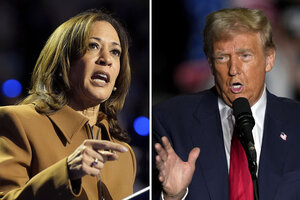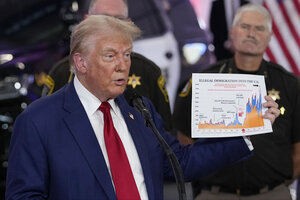Harris and Trump think big on energy – in very different directions
Former President Donald Trump has called climate change a “hoax” and has questioned whether scientists know that the world is heating. Vice President Kamala Harris has called it an existential threat and has been instrumental in directing federal money to clean energy initiatives.
In many ways, the U.S. presidential candidates could not seem more different when it comes to climate change or the future of America’s energy systems.
Yet along with the dramatic differences, there may be some common ground between the two presidential candidates’ positions on climate change and energy, says Brad Townsend, vice president for policy and outreach at the Center for Climate and Energy Solutions.
Why We Wrote This
Kamala Harris and Donald Trump both paint a future with abundant energy. Her plans center on renewable sources. He backs traditional fuels, rejecting climate change as a priority.
“Both seem to be of the mind that energy is prosperity,” he says. “They just have different views about how to make that prosperity materialize.”
Both candidates, for instance, have said they want it to be easier for energy companies to get approval for new infrastructure, and both support what is generally known as “permitting reform” – efforts to streamline the regulatory process for new facilities. But a key difference between the two is which energy sources they most support.
Oil and gas
Mr. Trump is a big booster of fossil fuels – the coal, oil, and gas that have traditionally formed the base of the U.S. energy economy. Ms. Harris has taken a “yes, and” position. Domestic oil production set new records under the Biden administration, and Ms. Harris has said she would not try to ban fracking (hydraulic fracturing), a way of mining natural gas that environmentalists say is ecologically damaging. But her focus is on developing what many experts see as the next generation of energy – wind, solar, and other renewables.
Global role on climate change
Mr. Trump has said he would withdraw the United States from the world’s main climate agreement – something he already did once during his first term as president (a move reversed by President Joe Biden). During the Trump presidency, Ms. Harris said abandoning the global agreement would be “catastrophic for our planet, for ourselves, and for future generations.”
Power plants and pollution
Mr. Trump has pledged to roll back a regulation that limits carbon emissions from coal and gas power plants. Ms. Harris was part of the administration that established those rules, and as California attorney general, she prosecuted big polluters.
Federal investment in clean energy
The $437 billion dollar Inflation Reduction Act is widely seen as the country’s largest-ever investment in climate change adaptation and resilience. The act was designed to fund the research and development of new clean energy sources, but also to supercharge private investment into existing clean energy technology.
Boosters framed it as an economics and jobs act as much as an environmental one; the underlying goal was to help the U.S. become a leader in what the Biden administration characterized as the inevitable economy of the future – whether that includes electric vehicles or clean hydrogen. One of Ms. Harris’ main priorities, if she’s elected, will likely be to continue to administer this money, 85% of which is supposed to go to clean energy initiatives, climate resilience efforts, and other measures related to climate change.
After young climate protesters demonstrated outside her Los Angeles home this September, Ms. Harris promised that she would “confront the climate crisis with bold action, building a clean energy economy, advancing environmental justice, and increasing resilience to climate disasters.”
Mr. Trump, for his part, has characterized the Inflation Reduction Act as an unfair payment to clean energy companies at the expense of the fossil fuel industry. Mr. Trump says he would pull back billions of unspent dollars and may end tax incentives for some electric vehicles. Some experts, however, note that most of the act’s investments and jobs are in Republican congressional districts.
One of the biggest differences between a Trump and a Harris presidency might be in their relationship with the government agencies that work in energy or the environment.
During the Trump administration, for instance, scores of professional scientists left the Environmental Protection Agency, with many researchers claiming that they faced retaliation and harassment for reporting their findings on climate change. As president, Mr. Trump both reversed a slew of environmental regulations and successfully lobbied to cut the EPA’s budget. Much of the country’s clean air and water enforcement, climate resilience efforts, weather forecasting, national park maintenance, and other everyday environmental tasks are implemented by federal agencies.

















